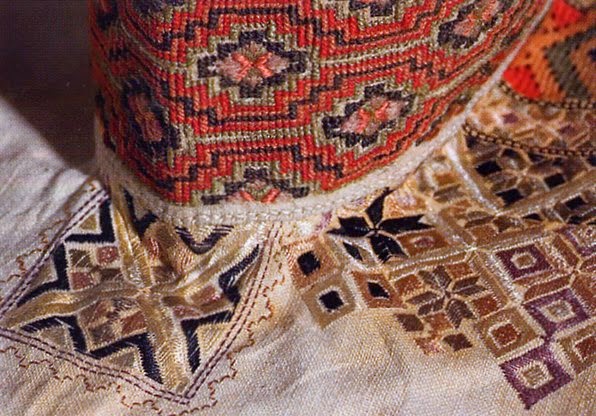Hello all,
Today I will continue my series on East Telemark costume by talking about the shirts. This garment is called skjorte, and was and is worn by women with both the Raudtrøye and Beltestakkcostumes, and even the Stakk og LIv, but without embroidery, and by men with the Gråtrøje costume. The man's shirt for the Snippekufte and Rundtøje costumes were different.
The earliest known garment of this type which still exists dates back to 1798, and undoubtedly they were made still earlier. The embroidery on these shirts flourished in the 19th cent. It was toned down a bit later with the advent of Pietism and the availability of printed cloth, but was enthusiastically revived in the 20th cent. The drawing above was made in 1844 of Kirsten Olsdatter in Heddal. Here is another drawing of the same woman. She is wearing the old form of the Raudtrøye costume.
You can see in these two images that the shirt is extensively embroidered. I have documented 7 different types of embroidery which are used on these shirts. Here is the oldest known skjorte, which I alluded to above.
The arrangement of the embroidery is substantially the same as is known today, and so is the cut, except that this shirt has shoulder insets like in West Telemark. It is easy to see cross stitch and holbein stitch, holbeinsting, in the embroidery. There are three variants of the cut used for this garment, they are shown here in chronological order, from earlier to later. Notice that the shoulder inset is no longer used.
The skjorte of the early 19th cent.generally have no cuffs, the embroidery being done directly on the sleeve ends, as in the above example. Later the shirts were made with cuffs. For a period in between, for formal occasions, two shirts were worn, one without cuffs being worn over one with cuffs.
Here are a couple more examples of early shirts.
In this one above, we see satin stitch embroidery, but of a somemwhat different style than that seen later.
In this example, the collar is executed in typical East Telemark satin stitch, plattsaum. The front panel is executed in three techniques, from the opening out: needleweave hemstitch, uttrekksaum, thencross stitch, kross-saum, and counted satin stitch, klostersaum. The sleeve end is done in rosesaum type satin stitch.
There are two more common stitches used in this embroidery. Darning stitch and gobelin stitch, gobelinsting. Here is a collar which uses darning stitch, smøyg, alone.
This is an extremely ancient technique which is found in scattered places all over Europe and Asia. In East Telemark it is most commonly combined with gobelin and other stitches.
This is reminiscent of Hutsul embroidery, and yet the effect is different. Sometimes the technique is exactly the same, and the only difference is in the choice of colors.
Here is a collar in progress in gobelin stitch, from front and back.
The standing collar consists of one layer of cloth. The edge is toothed, which is made by executing hemstiched posts and then folding the cloth in the middle of it, and then securing the two edges together. There is a small overlap along the top of the collar.
The embroidery techniques are combined in various ways, and certain motifs recur often. I will use the rest of this article to give you more examples.

Here is an example from 1818 with modest embroidery.
Here above is a sleeve end embroidered in uttrekksaum. The next few images show that the shoulders were also sometimes embroidered.
Thank you for reading. I hope that you have found this to be interesting and inspiring. There are many ideas here which could be used for many types of projects.
Roman K.
email: rkozakand@aol.com
Some online resources:
Norwegian digital Museum, lots of images of old garments.
http://www.digitaltmuseum.no/things/skjorte/TEM/TGM-BM.1912:185another couple, the girl in the revived Beltestakk, the boy in some odd hybrid costume.
https://www.youtube.com/watch?v=cLWgqiaNyC4
Blog of a woman who made a beltestakk, in Norwegian with photographs.
http://kreativinspirasjon.wordpress.com/category/beltestakk/
Norwegian costumes are readily available, if expensive. Do a search under Husflid or Heimen,
with the name of the costume in which you are interested. Here are a couple possible sources.
http://www.norskflid.no/bunad/bunader/telemark/oest-telemark-beltestakk-mod-fra-skien/
http://www.heimen.net/Produkt/Aust-Telemark+-+Beltestakk+A82
Source Material:
Aagot Noss, 'Draktskikk i Aust-Telemark', Oslo, 2010
Kari-Anne Pedersen, 'Folkedrakt blir Bunad', Cappelen Damm, 2013
Bjorn Sverre hol Haugen, 'Norsk Bunadleksikon' Oslo, 2009
Kjersti Skavhaug et al, 'Norwegian Bunads', Oslo, 1991
Heidi Fossnes, 'Norges Bunader og Samiske Folkedrakter', Oslo, 1993
Ellen Scheel et al, 'Bunad-Brodering', Oslo, 1997
Janice Stewart, 'The Folk Arts of Norway', University of Wisconsin, 1953
Guvnor Traetteberg, 'Folk Costumes of Norway', Oslo, 1966, 1976
Thorbjorg Ugland, 'A Sampler of Norway's Folk Costumes', Oslo, 1996
Laila Duran, 'Scandinavian Folklore vol I - III', Sweden, 2011-2013











 \
\


















































